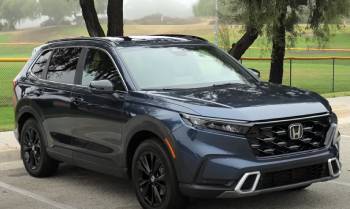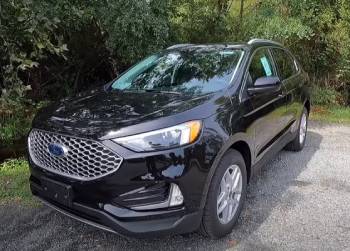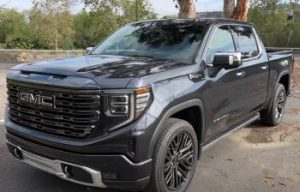Choosing a car can be an exhilarating yet exhausting experience. After all, you’re committing to a piece of machinery you’ll probably have for several years. When it comes to reliable SUVs, the Honda CR-V and the Ford Edge tend to pop up on people’s shortlists. But which one should you go for?
Sit tight, as we’re about to dissect the pros and cons of these two popular SUVs to help you make an informed decision.
A Brief Comparison Table
| Feature | Honda CR-V | Ford Edge |
| Starting Price | Lower | Higher |
| Engine Options | 1.5L Turbo-4 (190 hp) | 2.0L Turbo-4 (250 hp), 2.7L V6 (335 hp) |
| Fuel Economy (City/Highway) | 28/34 MPG | 21/29 MPG |
| Towing Capacity | 1,500 pounds | 3,500 pounds |
| Safety Features | Honda Sensing | Ford Co-Pilot360 |
| Cargo Space (Max) | 75.8 cubic feet | 73.4 cubic feet |
| Infotainment Screen Size | 7-inch | 8-inch |
| Apple CarPlay/Android Auto | Available | Standard |
| Interior Space | Spacious but utilitarian | More room and premium feel |
Honda CR-V: The Epitome of Reliability

Let’s kick things off with the Honda CR-V, a car that’s almost synonymous with the word ‘reliable.’
Pros:
- Fuel Efficiency:
The Honda CR-V is one of the most fuel-efficient SUVs in its class. You can expect about 28 MPG in the city and 34 MPG on the highway with its base engine.
- Roomy Interior:
The CR-V offers a spacious, comfortable interior with plenty of room for adults in both rows.
- Cargo Space:
Need room for luggage? The Honda CR-V offers a generous 39.2 cubic feet of cargo space, which expands to 75.8 cubic feet when the rear seats are folded down.
- Safety Features:
Honda Sensing, Honda’s suite of safety features, is available on most trims. This includes collision mitigation braking, road departure mitigation, and adaptive cruise control.
- Affordability:
With its starting price usually lower than the Ford Edge, the CR-V can be a more economical choice for budget-conscious buyers.
Cons:
- Power:
If you’re looking for a performance-oriented vehicle, the CR-V might disappoint. Its base engine, a 1.5L turbo-4, lacks the oomph that some may desire.
- Infotainment System:
Though functional, the 7-inch display is somewhat dated, and the system could be more intuitive.
- Towing Capacity:
Don’t expect to tow your boat with the CR-V. Its towing capacity is limited to 1,500 pounds.
Also Read: Differences Between Hercules H/P 4000 And Cooper Cobra Tires.
Ford Edge: American Muscle Meets Family-Friendly

Now, let’s shift gears to the Ford Edge. This American-made SUV brings its own set of unique features to the table.
Pros:
- Powerful Engine:
The Ford Edge packs a punch with its standard turbocharged four-cylinder engine, putting out 250 horsepower. If you crave more, there’s a V6 option with 335 horsepower.
- Spacious Cabin:
The Edge offers a roomy, well-appointed interior with high-quality materials.
- Tech-Savvy:
With the Ford SYNC 3 infotainment system, you get an 8-inch touchscreen, Apple CarPlay, and Android Auto as standard features.
- Safety:
Ford’s Co-Pilot360, a suite of safety features, comes standard. This includes blind-spot monitoring, lane-keeping assist, and a rearview camera.
- Towing Capacity:
If towing is essential for you, the Edge can pull up to 3,500 pounds.
Cons:
- Fuel Efficiency:
While not terrible, it doesn’t match the Honda CR-V. Expect about 21 MPG in the city and 29 MPG on the highway.
- Price:
The Ford Edge generally starts at a higher price point than the Honda CR-V, which might be a turn-off for some buyers.
- Less Cargo Space:
The Edge offers 39.2 cubic feet of cargo space, virtually identical to the CR-V. However, when you fold the rear seats, it expands to only 73.4 cubic feet.
Key Differences Between Honda CR-V and Ford Edge
After an initial glance, you might think the Honda CR-V and Ford Edge are birds of the same feather. After all, they’re both five-passenger SUVs ideal for families, right?
Well, not so fast. While these two popular SUVs share some similarities, they also have key differences that set them apart. Let’s delve deep into what makes each one unique.
Power and Performance
If you’re looking for sheer power, the Ford Edge has the Honda CR-V beat. Ford offers a standard turbocharged four-cylinder engine with 250 horsepower. If that’s not enough to quench your thirst for speed, there’s an available 2.7L V6 with a whopping 335 horsepower.
In contrast, the CR-V’s 1.5L turbo-4 engine offers 190 horsepower, making it less of a beast when it comes to raw power. The CR-V is a bit more subdued and focuses on fuel economy rather than all-out power.
Fuel Efficiency
Speaking of fuel economy, this is where the Honda CR-V takes the cake. Offering 28 MPG in the city and 34 MPG on the highway, the CR-V is a frequent flyer’s dream. In contrast, the Ford Edge lags a bit, providing 21 MPG in the city and 29 MPG on the highway. If saving at the pump is a priority, the Honda CR-V might be the better choice for you.
Safety Features
Both vehicles come equipped with impressive suites of safety features. The Honda CR-V offers the Honda Sensing suite, which includes features like collision mitigation braking, road departure mitigation, and adaptive cruise control.
On the other hand, the Ford Edge offers Ford’s Co-Pilot360, which includes blind-spot monitoring, lane-keeping assist, and a rearview camera. While both are well-equipped, the CR-V’s safety suite is generally considered more comprehensive, making it a slightly better option for those ultra-concerned about safety.
Interior and Comfort
When it comes to interior space and comfort, both vehicles offer ample room for passengers. However, the Ford Edge is generally larger, providing more legroom and shoulder space for passengers.
The materials used in the Ford Edge also tend to be more premium, especially in the higher trims. The CR-V, while roomy and comfortable, has a more utilitarian interior design.
Technology and Infotainment
The Ford Edge is undeniably more tech-savvy. With its standard Ford SYNC 3 infotainment system, which includes an 8-inch touchscreen, Apple CarPlay, and Android Auto, the Edge offers a slightly more refined technological experience.
The Honda CR-V isn’t far behind but uses a somewhat dated 7-inch display that some users find less intuitive.
Towing Capacity
If you’re someone who needs to tow trailers or boats, the Ford Edge has a distinct advantage. It boasts a towing capacity of up to 3,500 pounds. On the other hand, the Honda CR-V has a limited towing capacity of 1,500 pounds, making it less suitable for heavy towing tasks.
Price and Affordability
Last but not least, let’s talk about the elephant in the room: the price. The Ford Edge generally starts at a higher price point than the Honda CR-V. While it offers more features, especially in the higher trims, it’s essential to consider whether these added benefits align with your budget.
Also Read: Should You Get Geoshield Tint?
Frequently Asked Questions (FAQs)
Yes, the Ford Edge is generally longer and wider than the Honda CR-V, offering more passenger space but similar cargo space.
In terms of size and performance, the Honda Passport is more comparable to the Ford Edge than the CR-V.
“Better” is subjective and depends on what you’re looking for. Ford tends to offer more power and towing capacity, while Honda is known for reliability and fuel efficiency.
Both SUVs offer 39.2 cubic feet of cargo space behind the rear seats. However, the CR-V expands to 75.8 cubic feet, slightly more than Edge’s 73.4 cubic feet.
Ford’s direct competitor to the CR-V would be the Ford Escape, which also falls in the compact SUV category.
No, the Ford Edge is not considered a luxury SUV, but its higher trims offer luxurious features like leather seats and advanced infotainment systems.
The Bottom Line
Both the Honda CR-V and Ford Edge have their merits. If you’re looking for reliability and fuel efficiency, go for the CR-V. If you need more power and towing capacity, the Edge is your SUV. Ultimately, your choice boils down to what you prioritize more in a vehicle.
Ultimately, the Honda CR-V and Ford Edge serve different niches within the SUV market. The CR-V is ideal for those who prioritize fuel efficiency, reliability, and a comprehensive safety suite. In contrast, the Ford Edge is perfect for those who want more power, a tech-savvy experience, and additional space. Your final decision will hinge on what features are most important to you and your lifestyle. Happy driving!



